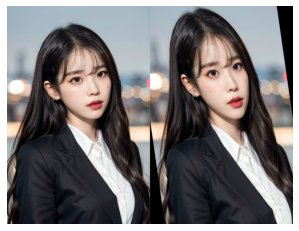变换
OpenCV提供了cv2.warpAffine和cv2.warpPerspective两个转换函数,cv2.warpAffine采用2x3的转换矩阵,cv2.warpPerspective采用3x3转换矩阵。
缩放
使用cv2.resize实现图像的缩放,可以指定缩放尺寸或缩放比例,以及插值方法。首选的插值方法是用于缩小的 cv2.INTER_AREA 和用于缩放的 cv2.INTER_CUBIC(慢)和 cv2.INTER_LINEAR。cv2.INTER_LINEAR是默认的缩放插值方法。可以用一下两种方法实现:
import numpy as np
import cv2
img = cv2.imread('face.png')
res = cv2.resize(img, None,fx=2, fy=2, interpolation = cv2.INTER_CUBIC)
# OR
height, width = img.shape[:2]
res = cv2.resize(img,(2*width, 2*height), interpolation = cv2.INTER_CUBIC)
平移
如果在(x,y)方向上的平移量为$(t_x,t_y)$,则可以得到转换矩阵M:
$$
M=\begin{bmatrix} 1 & 0 & t_x \\ 0 & 1 & t_y \end{bmatrix}
$$
将其转换为np.float32的numpy数组并传入cv2.warpAffine函数,以平移(100,50)为例:
rows,cols,_ = img.shape
M = np.float32([[1,0,100],[0,1,50]])
dst = cv2.warpAffine(img,M,(cols,rows))

cv2.warpAffine的第三个参数是输出图像的大小,形式为(width,height)
旋转
图像旋转角度为$\theta$是通过以下变换矩阵实现的:
$$
M = \begin{bmatrix} \cos\theta & -\sin\theta \\ \sin\theta & \cos\theta \end{bmatrix}
$$
OpenCV提供了可缩放的旋转和可调整的旋转中心,修改后的变换矩阵为:
$$
\begin{bmatrix} \alpha & \beta & (1- \alpha ) \cdot center.x - \beta \cdot center.y \\ - \beta & \alpha & \beta \cdot center.x + (1- \alpha ) \cdot center.y \end{bmatrix}
$$
其中:
$$
\alpha=scale\cdot\cos\theta,\\\beta=scale\cdot\sin\theta
$$
为了得到该变换矩阵,OpenCV提供了cv2.getRotationMatrix2D函数,以将图像相对于中心旋转逆时针90度缩放比例为1:
rows,cols,_ = img.shape
# cols-1 和 rows-1 是坐标限制
M = cv2.getRotationMatrix2D(((cols-1)/2.0,(rows-1)/2.0),90,1)
dst = cv2.warpAffine(img,M,(cols,rows))

仿射变换(Affine Transformation)
在仿射转换中,原始图像中的所有并行线仍将在输出图像中平行。为了得到转换矩阵,需要从输入图像中的三个点及其在输出图像中的对应位置。通过cv2.getAffineTransform函数创建一个2x3的矩阵,并传递给cv2.warpAffine。
rows,cols,ch = img.shape
pts1 = np.float32([[100,100],[100,400],[400,100]])
pts2 = np.float32([[50,50],[100,400],[350,50]])
M = cv2.getAffineTransform(pts1,pts2)
dst = cv2.warpAffine(img,M,(cols,rows))

透视变换(Perspective Transformation)
透视转换需要一个3x3转换矩阵。即使在转换后,直线也将保持直线。需要在输入图像上有四个点,在输出图像中需要对应的四个点,其中三个点不共线。可通过cv2.getPersperctiveTransform得到变换矩阵,并传递给cv2.warpPerspective。
rows,cols,ch = img.shape
pts1 = np.float32([[40,100],[400,100],[0,400],[360,400]])
pts2 = np.float32([[0,0],[500,0],[0,500],[500,500]])
M = cv2.getPerspectiveTransform(pts1,pts2)
dst = cv2.warpPerspective(img,M,(cols,rows))

